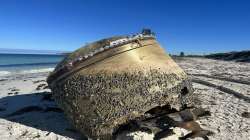Australia: Officials confirm mysterious object on beach as debris from Indian PSLV operated by ISRO
"We have concluded the object located on a beach near Jurien Bay in Westeran Australia is most likely debris from an expended third-stage of a Polar Satellite Launch Vehicle (PSLV)," said the agency in a tweet

A dome-shaped mysterious object that was found on a remote Australian beach has been confirmed as debris from an Indian space vehicle operated by the Indian Space Research Organisation (ISRO). The canister is a part of a Polar Satellite Launch Vehicle (PSLV) by ISRO.
In a statement, the Australian Space Agency said that it is working with the ISRO and will provide confirmation to determine next steps like considering obligations under the United Nations space treaties.
"We have concluded the object located on a beach near Jurien Bay in Western Australia is most likely debris from an expended third-stage of a Polar Satellite Launch Vehicle (PSLV)," said the agency in a tweet.
Meanwhile, Sudheer Kumar, a director at ISRO, also confirmed that the canister belongs to the PSLV operated by ISRO. The Indian space organisation told CNN that there were "no such plans as of now to bring the object back to India."
The canister was discovered near the beach in Green Head in Western Australia (WA) about 250 kilometres north of the city of Perth last month. The bizarre-looking object has been declared a piece of space junk, and it appeared to be damaged at one end and is covered with barnacles, indicating that it has spent a significant amount of time at sea before washing up.
Police earlier labelled the object as "hazardous" as they worked to identify if there was a risk to the community. After analysis of the object, the Department of Fire and Emergency Services and the Chemistry Centre of WA found it posed no risk to the community. But Boyd said it was important people did not touch the object. "It might still have some residual fuel and you just don't want to get people touching that," she said.
Space debris – both man-made and natural – has a habit of coming down in WA’s vast outback, although it is rare for it to be found washed up on the state’s 12,895 kilometres of coastline. Most famously, the Skylab space station came hurtling back to Earth in 1979, with pieces of the rogue station found in the most remote of outback locations in Balladonia, north-east of Esperance in WA’s south.
There were many speculations about the origins of the object. Space experts agreed, with Australian National University astrophysicist Dr Doris Grosse and Flinders University space archaeologist Dr Alice Gorman believing it was likely a fuel cylinder from the third stage of a launch by India’s space agency, it said. Some even theorised the debris could have come from a specific mission – PSLV-CA C46 – which launched in May 2019 and dropped some debris in the ocean to Australia’s north-west and south-east, the report added.
ALSO READ | Australia: Space experts believe 'mysterious object' on beach could be piece of 20-year-old Indian rocket

